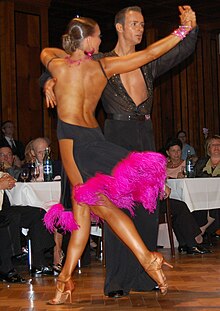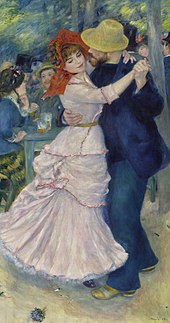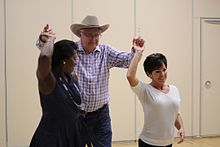
Ballroom dance is a set of European partner dances, which are enjoyed both socially and competitively around the world, mostly because of its performance and entertainment aspects. Ballroom dancing is also widely enjoyed on stage, film, and television.
In partner dancing, connection is physical, non-verbal communication between dancers to facilitate synchronized or coordinated dance movements. Some forms of connection involve "lead/follow" in which one dancer directs the movements of the other dancer by means of non-verbal directions conveyed through a physical connection between the dancers. In other forms, connection involves multiple dancers without a distinct leader or follower. Connection refers to a host of different techniques in many types of partner dancing, especially those that feature significant physical contact between the dancers, including the Argentine Tango, Lindy Hop, Balboa, East Coast Swing, West Coast Swing, Salsa, and other ballroom dances.
The following outline is provided as an overview of and topical guide to dance:
In some types of partner dance, lead and follow are designations for the two dancers' roles in a dance pairing. The leader is responsible for guiding the couple and initiating transitions to different dance steps and, in improvised dances, for choosing the dance steps to perform. The leader communicates choices to the follower, and directs the follower by means of subtle physical and visual signals, thereby allowing the pair to be smoothly coordinated.
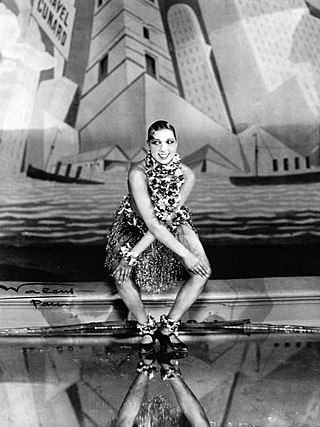
The Charleston is a dance named after the harbor city of Charleston, South Carolina. The rhythm was popularized in mainstream dance music in the United States by a 1923 tune called "The Charleston" by composer/pianist James P. Johnson, which originated in the Broadway show Runnin' Wild and became one of the most popular hits of the decade. Runnin' Wild ran from 28 October 1923, through 28 June 1924. The peak year for the Charleston as a dance by the public was mid-1926 to 1927.
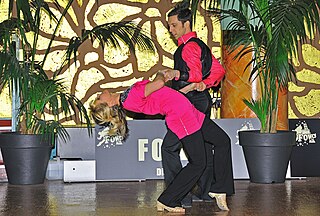
West Coast Swing is a partner dance with roots in Lindy Hop. It is characterized by an elastic look that results from its extension-compression technique of partner connection and is danced primarily in a slotted area on the dance floor. The dance allows for both partners to improvise steps while dancing together, putting West Coast Swing in a short list of dances that emphasize improvisation.

Swing dance is a group of social dances that developed with the swing style of jazz music in the 1920s–1940s, with the origins of each dance predating the popular "swing era". Hundreds of styles of swing dancing were developed; those that have survived beyond that era include Charleston, Balboa, Lindy Hop, and Collegiate Shag. Today, the best-known of these dances is the Lindy Hop, which originated in Harlem in the early 1930s. While the majority of swing dances began in African-American communities as vernacular African-American dances, some influenced swing-era dances, like Balboa, developed outside of these communities.

In partner dancing, closed position is a category of positions in which partners hold each other while facing at least approximately toward each other.

The schottische is a partnered country dance that apparently originated in Bohemia. It was popular in Victorian era ballrooms as a part of the Bohemian folk-dance craze and left its traces in folk music of countries such as Argentina, Finland ("jenkka"), France, Italy, Norway ("reinlender"), Portugal and Brazil, Spain (chotis), Sweden, Denmark ("schottis"), Mexico, and the United States, among other nations. The schottische is considered by The Oxford Companion to Music to be a kind of slower polka, with continental-European origin.

Social dances are dances that have social functions and context. Social dances are intended for participation rather than performance. They are often danced merely to socialise and for entertainment, though they may have ceremonial, competitive and erotic functions.
Western promenade dances are a form of partner dance traditionally danced to country-western music, and which are stylistically associated with American country and/or western traditions.
This is a list of dance terms that are not names of dances or types of dances. See List of dances and List of dance style categories for those.
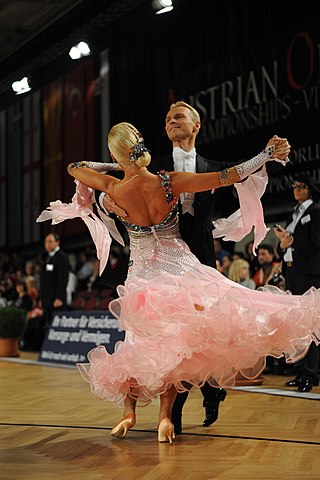
In ballroom dancing, directions of progressive movement, in particular directions of steps, can be indicated either in relation to the room or in relation to the body position. Directions of turns, although there are only two of them, may also be indicated in several ways.

Merengue is a style of Dominican music and dance. Merengue is the national dance of the Dominican Republic and is also important to national identity in the country. It is a type of danced walk and is accessible to a large variety of people with or without dance experience. The music of merengue draws influence from European and Afro-Cuban styles and mainly uses instruments like guitars, drums, and a charrasca or metal scraper. The dance originated as a rural dance and later became a ballroom dance. Merengue has three distinct sections: the paseo, the merengue proper, and the closing jaleo which includes improvisation.

The hornpipe is any of several dance forms played and danced in Britain and Ireland and elsewhere from the 16th century until the present day. The earliest references to hornpipes are from England, with Hugh Aston's Hornepype of 1522 and others referring to Lancashire hornpipes in 1609 and 1613.
The basic step, basic figure, basic movement, basic pattern, or simply basic is the dance move that defines the character of a particular dance. It sets the rhythm of the dance; it is the default move to which a dancer returns, when not performing any other moves. More formally, it can be defined as a "rhythmic step pattern" in the form of a "consistent and recurring grouping of weight changes" between the feet which is rhythmic and repeated for the length of a song. For some dances it is sufficient to know the basic step performed in different handholds and dance positions to enjoy it socially.
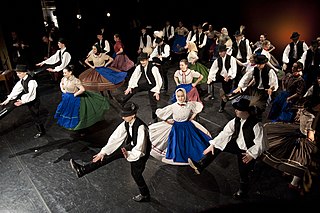
Hungarian dance refers to the folk dances practised and performed by the Hungarians, both amongst the populations native to Hungary and its neighbours, and also amongst the Hungarian diaspora.
Osman Resul Taka was a Cham Albanian dancer and unclear personage from 19th century. The Dance of Osman Taka is named after him. His early life is not clear. He belongs to the Taka clan of Filiates, also known for Alush Taka, an Albanian patriot.
According to narrative sources, his name became well-known during the mid 19th century. He was probably a kachak or klepht fighting the Ottomans in Chameria region. Other sources connect him with the Albanian National Awakening of late 19th century. He was jailed in Yanina and was sentenced to death. When he was asked to give his final wish, he wanted to dance. The folk tradition says that his dance was so beautiful that the local Albanian gendarmes of the Ottoman army, did not execute him. After some days he was caught again and was killed in Konispol.
The promenade position is a dance position in ballroom and other dances. It is described differently in various dance categories.
